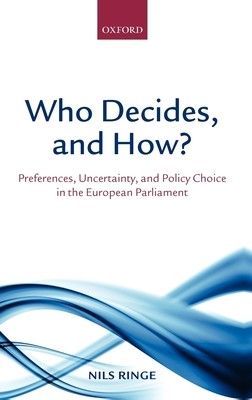
- We will send in 10–14 business days.
- Author: Nils Ringe
- Publisher: Oxford University Press, USA
- ISBN-10: 0199572550
- ISBN-13: 9780199572557
- Format: 15.8 x 23.4 x 2.3 cm, kieti viršeliai
- Language: English
- SAVE -10% with code: EXTRA
Reviews
Description
How do individual legislators in the European Parliament (EP) make decisions on the wide variety of policy proposals they routinely confront? Despite a flourishing literature on the European Union's only directly elected institution, we know surprisingly little about the micro-foundations of EP politics. Who Decides, and How? seeks to address this shortcoming by examining how individual legislators make policy choices, how these choices are aggregated, and what role parties and committees play in this process. It argues that members of the EP lack adequate resources to make equally informed decisions across policy areas. Therefore, when faced with policy choices in policy areas outside their realms of expertise, members make decisions on the basis of perceived preference coherence: they adopt the positions of their expert colleagues in the responsible EP committee whose preferences over policy outcomes they believe to most closely match their own. These preferences are difficult
to determine, however, which is why legislators rely on a shared party label as stand-in for common preferences. This results in cohesive parties, despite the inability of EP parties to discipline their members.
EXTRA 10 % discount with code: EXTRA
The promotion ends in 21d.19:23:35
The discount code is valid when purchasing from 10 €. Discounts do not stack.
- Author: Nils Ringe
- Publisher: Oxford University Press, USA
- ISBN-10: 0199572550
- ISBN-13: 9780199572557
- Format: 15.8 x 23.4 x 2.3 cm, kieti viršeliai
- Language: English English
How do individual legislators in the European Parliament (EP) make decisions on the wide variety of policy proposals they routinely confront? Despite a flourishing literature on the European Union's only directly elected institution, we know surprisingly little about the micro-foundations of EP politics. Who Decides, and How? seeks to address this shortcoming by examining how individual legislators make policy choices, how these choices are aggregated, and what role parties and committees play in this process. It argues that members of the EP lack adequate resources to make equally informed decisions across policy areas. Therefore, when faced with policy choices in policy areas outside their realms of expertise, members make decisions on the basis of perceived preference coherence: they adopt the positions of their expert colleagues in the responsible EP committee whose preferences over policy outcomes they believe to most closely match their own. These preferences are difficult
to determine, however, which is why legislators rely on a shared party label as stand-in for common preferences. This results in cohesive parties, despite the inability of EP parties to discipline their members.


Reviews